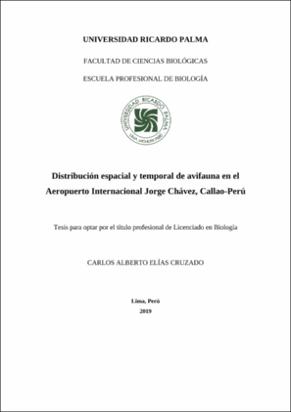Mostrar el registro sencillo del ítem
Distribución espacial y temporal de avifauna en el Aeropuerto Internacional Jorge Chávez, Callao-Perú
| dc.contributor.advisor | Madrid Ibarra, Flor de María | |
| dc.contributor.author | Elias Cruzado, Carlos Alberto | |
| dc.date.accessioned | 2019-09-23T17:51:10Z | |
| dc.date.available | 2019-09-23T17:51:10Z | |
| dc.date.issued | 2019-07 | |
| dc.identifier.uri | https://hdl.handle.net/20.500.14138/2347 | |
| dc.description.abstract | Alrededor de los aeropuertos se encuentran condiciones externas que resultan ser atrayentes para las aves las cuales incluyen: humedales, pastizales, sembríos, manglares, desmontes de residuos orgánicos provenientes de actividades antrópicas, además las pistas de rodaje para las aeronaves son foco de tránsito permanente de aves. El aeropuerto Internacional Jorge Chávez (AIJCh) ubicado en Lima, Perú presenta muchos de los factores mencionados por lo que la evaluación de la fauna aviar es necesaria. El objetivo de este trabajo es realizar la evaluación espacial y temporal mediante censos por punto de conteo durante noviembre del 2015 hasta julio 2016 y utilizar el Índice de Evaluación de Riesgo Aviario (IERA) para detectar aquellas que generan riesgo. Las especies que presentaron mayor abundancia fueron las gaviotas (Familia Laridae) con un máximo reportado de 5189 individuos y los gallinazos (Coragyps atratus) con un máximo reportado de 371 individuos. Así mismo ambos grupos estuvieron más activos a partir de las primeras horas de la mañana (9:00 horas) y en la media tarde (16:00-17:00 horas). Estos grupos también presentaron mayor riesgo según el IERA. Dicho índice funciona eficientemente como herramienta de diagnóstico de especies de aves potencialmente peligrosas. Around airports, there are external conditions that turn out to be attractive for birds that include wetlands, grasslands, crops, mangroves, organic waste from human activities, and taxiways for aircraft which are permanent source for bird transit. Jorge Chávez International Airport (AIJCh) located in Lima, Peru presents many of the factors above mentioned, so the evaluation of avian fauna is necessary. The objective of this work is to perform the spatial and temporal evaluation through surveys during, November 2015 until July 2016 and use the Avian Risk Assessment Index (IERA in Spanish) to detect those species that generate the greatest risk. The groups of species that presented greater abundance were the gulls (Family Lariade) with a maximum reported of 5189 individuals and the “black vulture” (Coragyps atratus) with a maximum reported of 371 individuals. Likewise, both groups were more active from the first hours of the morning (9:00 am) and in the mid-afternoon (4:00 pm to 5:00 pm). In addition these groups also presented higher risk according to the IERA. This index works efficiently as a diagnostic tool for potentially dangerous bird species for air navigation. | es_ES |
| dc.description.sponsorship | Submitted by Wong Rafael (rafel_wl@hotmail.com) on 2019-09-23T17:51:10Z No. of bitstreams: 2 Elias_ca.pdf: 1244992 bytes, checksum: 4e22575ffc0635289c20bad1e692757c (MD5) Elias_ca.pdf: 1244992 bytes, checksum: 4e22575ffc0635289c20bad1e692757c (MD5) | es_ES |
| dc.description.sponsorship | Made available in DSpace on 2019-09-23T17:51:10Z (GMT). No. of bitstreams: 2 Elias_ca.pdf: 1244992 bytes, checksum: 4e22575ffc0635289c20bad1e692757c (MD5) Elias_ca.pdf: 1244992 bytes, checksum: 4e22575ffc0635289c20bad1e692757c (MD5) Previous issue date: 2019-07 | es_ES |
| dc.description.uri | Tesis | es_ES |
| dc.format | application/pdf | |
| dc.language.iso | spa | |
| dc.publisher | Universidad Ricardo Palma - URP | es_ES |
| dc.rights | info:eu-repo/semantics/openAccess | |
| dc.rights.uri | https://creativecommons.org/licenses/by-nc-nd/4.0/ | |
| dc.source | Repositorio Institucional - URP | es_ES |
| dc.subject | Aeropuerto | es_ES |
| dc.subject | Peligro aviario | es_ES |
| dc.subject | Distribución espacial y temporal | es_ES |
| dc.subject | Airports | es_ES |
| dc.subject | avian risk | es_ES |
| dc.subject | spatial and seasonal distribution | es_ES |
| dc.title | Distribución espacial y temporal de avifauna en el Aeropuerto Internacional Jorge Chávez, Callao-Perú | es_ES |
| dc.type | info:eu-repo/semantics/bachelorThesis | |
| thesis.degree.discipline | Biología | es_ES |
| thesis.degree.grantor | Universidad Ricardo Palma. Facultad de Ciencias Biológicas. Escuela Profesional de Biología | es_ES |
| thesis.degree.level | Título Profesional | es_ES |
| thesis.degree.name | Licenciado en Biología | es_ES |
| dc.publisher.country | PE | es_ES |
| renati.type | https://purl.org/pe-repo/renati/type#tesis | |
| renati.level | https://purl.org/pe-repo/renati/nivel#tituloProfesional | |
| renati.discipline | 511206 | |
| dc.type.version | info:eu-repo/semantics/publishedVersion |
Ficheros en el ítem
Este ítem aparece en la(s) siguiente(s) colección(ones)
-
Biología [176]



